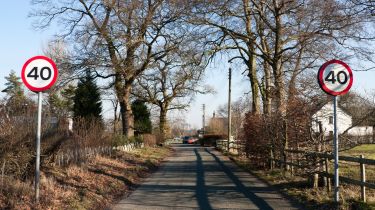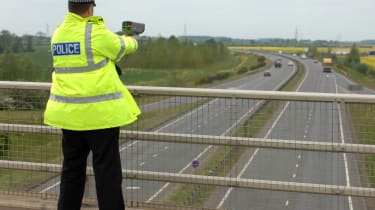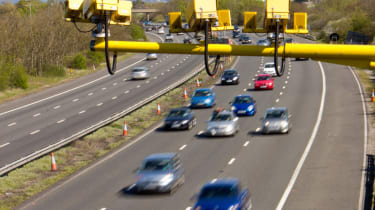UK speed limits: everything you need to know
Current UK speed limits explained, as well as their history and use
UK speed limits form an undeniably vital important part of our road network, and are on the front line of road safety. As motorists, we think about and engage with speed limits every day, they provide consistent regulation across the country and make it easier to prosecute those that break the law by exceeding the speed limit.
Speed limits in this country usually range from around 20mph up to the National Speed Limit, which itself varies depending on whether you’re on a motorway, a single carriageway or a dual carriageway, as well as according to the type of vehicle you’re in .
While the use of speed limits is an issue that can be discussed until the cows come home, speed limits are there, and are there for a reason. To help you understand and stick to these basic laws of the road, we've compiled this guide to keep you on the right side of the limit, even if you're driving a vehicle that requires you to know a different set of limits to the ones posted.
If you've passed your driving test, then the round speed limit signs would have been some of the first pieces of road furniture that you needed to identify. They are unique, with a white circle surrounded in red with black numbers within. These cover 20mph, 30mph, 40mph, 50mph and sometimes 60mph. In addition, there's the National Speed Limit sign, which is a white circle with a black diagonal line through it. This means the national limit applies, which is 60mph on single carriageway roads, and 70mph on dual carriageways.
However, as time passes, many drivers that simply use their cars to get from A to B without any involvement could even forget what the assorted limits are. To make matters worse, speed limits can be changed on roads without much in the way of notification, then there are other limits you need to be aware of, such as variable limits on smart motorways, or reduced speeds when roadworks are put in place.
When you're behind the wheel of a vehicle other than a conventional car, or if you're using your car to tow a caravan or trailer, then the speed limit that's posted at the roadside won't necessarily apply. These limits could be difficult to work out, but they will definitely be lower than the posted maximum you see on road signs. They will vary depending on the type of vehicle you're driving, too and when you add-in regional variations between Scotland, England and Wales, then it's easy to be confused about which speed limit is the right one for you to stick to.
Current UK speed limits by road and vehicle type
Below are the UK national speed limits as they currently stand. We've listed each type of vehicle class and the maximum speeds permitted on each type of road for that class.
UK speed limits for cars, motorbikes, and car-derived vans weighing up to two tonnes fully laden:
- • Restricted road: 30mph
- • Single carriageway: 60mph
- • Dual carriageway: 70mph
- • Motorway: 70mph
UK speed limits for a car* with a trailer:
- • Restricted road: 30mph
- • Single carriageway: 50mph
- • Dual carriageway: 60mph
- • Motorway: 60mph
(*Including motorbikes towing a trailer, or vans towing a trailer)
UK speed limits for buses, coaches and minibuses up to 12 metres long and goods vehicles weighing up to 7.5 tonnes:
- • Restricted road: 30mph
- • Single carriageway: 50mph
- • Dual carriageway: 60mph
- • Motorway: 70mph
UK speed limits for goods vehicles over 7.5 tonnes in England and Wales:
- • Restricted road: 30mph
- • Single carriageway: 50mph
- • Dual carriageway: 60mph
- • Motorway: 60mph
UK speed limits for goods vehicles over 7.5 tonnes in Scotland:
- • Restricted road: 30mph
- • Single carriageway: 40mph
- • Dual carriageway: 50mph
- • Motorway: 60mph
What are restricted roads, motorways and dual carriageways?
A restricted road is the technical name for roads that are in built up areas. In these busy situations, it can sometimes be difficult to work out the speed limit. However, if you can't see any speed limit signs, a good rule of thumb to follow is that if there are buildings and street lights lining the road, then the speed limit is 30mph. However, if the posted speed limit is higher than 30mph, then the different zone will be signified by the standard circular speed limit signs at the start of the zone, then smaller repeater signs will be placed on lamp posts or individual posts at regular intervals within the zone.
If the road doesn't have a physical divider between the two opposing streams of traffic then this is a single carriageway road. They can be formed of any number of variations from a single lane country road with passing places, to a wide five-lane road with something called a tidal flow for the centre lane, which is designed to operate in both directions to ease traffic congestion at peak times.
The other highway variant is the dual carriageway. These use a divider - either a grass verge or something more substantial, such as metal armco or concrete barriers. In very rare circumstances (often at the start of a multi-lane road) they can have single lanes in both directions, but more often they will have at least two lanes for each direction of traffic. Motorways are an evolution of the dual carriageway, and due to their higher speeds there are restrictions on the type of vehicles that can use them, with the slowest road users banned from them.
Other speed limits
We've listed the national speed limits above, but local authorities are able to impose different speed limits where they see fit. Usually this is to slow traffic on roads where the 60mph national speed limit would normally apply, although there is also the ability to add 20mph zones in urban areas. And on rare occasions the speed limit has been raised on a road in an effort to improve traffic flow.
These different speed limits are only ever lowered in increments of 10mph, and when they're 50mph or lower, there are no reduced limits for different classes of vehicle - the speed limit you see posted is the one you must not exceed.
Minimum speed limits
On even rarer occasions, you may see a round, blue road sign with a number in it. This is the minimum speed limit posted for a road. These limits are usually found in tunnels, where stationary or slow-moving traffic can be considered a traffic and pollution hazard to the free-flow of traffic through a tunnel. However, some would say that posting a minimum speed limit on regular roads could have a beneficial effect by improving the flow of traffic in general.
Speed limiters
While vans, goods vehicles, buses, coaches and minibuses have different limits to adhere to, many of these are becoming redundant, because commercial vehicles in certain classes are now required to have a speed limiter fitted as standard. Below is a list of the classes that need speed limiters, and the maximum speed they must be set to.
- • Buses, coaches and minibuses: 62mph
- • HGVs: 56mph or 53mph (depending on class)
- • Mopeds: 28mph
If you're a car driver, these limits are worth bearing in mind, because if you're travelling slower than this for no particular reason, your slower pace could hold up these vehicles. If they decide to try and overtake you on a dual carriageway, this could cause tailbacks due to the vehicle’s restricted speed.
If you see a van or other service vehicle with a sticker on the back proclaiming the vehicle is limited to a certain speed, this vehicle has been voluntarily fitted with a speed limiter, so that the fleet operators can help to keep costs in check.
UK speed limit history
At the dawn of the motor vehicle, towards the end of the 19th Century, the first 'horseless carriages' were considered as self-propelled locomotives - much like the large, heavy traction engines that started to appear in the 1850s. Pedestrians, cyclists and horses dominated the highways in those days, and these new 'locomotives' had to stick to already established speed limits for traction engines, so they didn't pose a threat to other road users.
That meant cars were restricted to 10mph by an 1860 law, although this dropped to 4mph in the country and 2mph in town with the introduction of the 1865 Red Flag Act. The Red Flag Act also meant that all vehicles should be escorted by a person walking 50 metres ahead to warn other road users of the imminent arrival of the horseless carriage. Another act in 1878 saw the flag removed and the escort placed only 20 metres ahead, but it wasn't until 1896 that this requirement was lifted. This landmark in car history is celebrated to this day by the London-Brighton veteran car run.
The limit was raised to 14mph with this act, and then it was raised again in 1903 to 20mph. Then, on 1 January 1931, speed limits were abolished completely. The government of the time deemed that the limit was held in such low regard that it wasn't worth bothering with, especially as many cars of the time didn't come with a working speedometer, nor was speed limit enforcement a consideration for the constabularies of the time.
Some semblance of order was restored in 1934, when Minister of Transport Leslie Hore-Belisha (the beacon man) introduced a trial 30mph limit for built up areas, the definition of which was anywhere with street lighting.
Speedometers were made compulsory on cars from 1937, while the outbreak of World War 2 saw a 20mph limit introduced at night, to help reduce casualties during the blackouts.
The 30mph limit became permanent in 1956, while in 1958 a raised 40mph limit was set in place to improve traffic flow. The next big changes came in the mid-1960s. A number of fatal accidents on foggy motorways saw an advisory 20mph limit introduced for fog, while a 70mph limit was experimented with for the winter months. The fog advisory later changed to 30mph, while the 70mph limit was put in place on a trial basis at the end of 1965. It became permanent in 1967, and the maximum 60mph limit for single carriageways was also introduced.
In December 1973, the oil crisis saw the national speed limit temporarily dropped to 50mph to save fuel, and while lower limits were in place for a couple of years, the standard limits were back in place by 1977. The 1984 Road Traffic Act is the legislation that currently enforces all speed limits, while the last set of changes in regulation occurred in 2015, when the limits for large HGVs on single and dual carriageways were raised to 50mph and 60mph respectively.
Speed limit enforcement
Speed limit enforcement is carried out by the police and fixed speed cameras, both of which can issue penalties for speeding, while local speed watch groups and vehicle activated signs are passive speed awareness devices.
UK speeding penalties
Below is a list of speed limits and the kind of penalty you can expect, depending on how much faster than the posted maximum you have gone:
| Speed limit | Fixed penalty or speed awareness course over: | Court summons over: |
| 20mph | 24mph | 35mph |
| 30mph | 35mph | 50mph |
| 40mph | 46mph | 66mph |
| 50mph | 57mph | 76mph |
| 60mph | 68mph | 86mph |
| 70mph | 79mph | 96mph |
If you earn more than six penalty points within 24 months of passing your test, your licence will be revoked and you'll have to go through the whole driving test again.
Now read about about the different types of UK speed cameras, how they work and what to look out for...
Find a car with the experts













